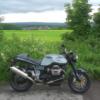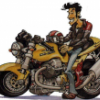
Skeeve
Members-
Posts
2,470 -
Joined
-
Last visited
-
Days Won
4
Skeeve last won the day on May 25 2015
Skeeve had the most liked content!
Profile Information
-
Location
Lo-cal So.Cal., where the money is plastic & the people are too!
-
My bike(s)
2003 Le Mans V11. WooHoo! :-D
Recent Profile Visitors
931 profile views
Skeeve's Achievements

"I live here" (5/5)
23
Reputation
-
Anybody know which ports on the broad sump to the cooler is which?
Skeeve replied to Weegie's topic in Technical Topics
The headlight is right where the oil cooler needs to be. The ram air ports to the airbox never did anything worth much until you're tapped out in top gear, according to reports, so what about using them & rerouting the airflow thru the cooler? Don't forget ducting to guide the outflow to a low pressure area, or it will all just hang around underneath the fairing sharing the heat around (which would be great when riding in cold weather, but I didn't think you got much of that in Oz?) -
Le Mans handlebar end weight: powder coated or standard paint spray?
Skeeve replied to p6x's topic in Technical Topics
I forget how much the Harbor Freight electrostatic spray gun is, but definitely sub $50... And their nylon powder is similarly cheap. The boys using it to coat their bullets don't even bother w/ the spray gun, they just throw it all in a plastic tub & agitate a bit; the powder adheres just fine. Ultimately, the OP gave us a trick question anyway, since the *correct* answer is secret hidden option #3, Manic Salamander brushed stainless replacements since the original equipment are lacking sufficient mass anyway... -
Doubt there's a market opportunity for it at this late date, but shortly after Guzzi unveiled the (2v) Griso, I was certain that there would have been more than a few V11 owners who would have liked to upgrade their bikes w/ the manky front x-over headers to the swoopy Griso style 2->1 job. Ah well, lost opperknockities....
-
Lots of old threads on V11LM about eliminating the front balance pipe. The bottom line is you eliminate some minor headaches and unnecessary weight with a negligible increase in the 4k rpm "hole" in the powerband [which is completely negated by one of the aftermarket x-overs & an ignition re-map.] If you already have or were planning to get a Stucchi or other x-over, then why not go ahead & eliminate any headaches that may result from the loose balance pipe down the road?
-
Is that red rear subframe/parcel rack structural or cosmetic? It almost looks like you could remove it & leave it in the garage for those days when you actually need it for tying gear to, but the rest of the year as your daily ride it would save you an easy 10# of unneeded steel?
-
Never cared for the fugly Quat-D exhaust. Rolling your own shouldn't be too hard, if you've got someone who can cut & weld stainless sheet.
-
I guess, technically, you can claim to be the only owner of a working Ippogrifo! [Guzzi's still-born show bike from the '90s based on the hemi-head small block aero engine...]
-
You can get a custom seat made, or you can remove the stock cover and foam, roughen/texturize the TPM seat base to provide some "tooth" and then apply some Bondo to smooth out all the sharp corners underneath the foam. Foam ultimately just compresses until you're sitting on the seat pan, so starting with a smooth seat pan is literally more than 1/2 the battle [maybe 3/4?] to distance riding comfort. I stumbled upon this truth years ago when trying to figure out why it was that the bikes back in the '70s all had crappy seats that never received the bitter complaints of the modern bikes that come from the factory with fancy, swoopy "speshuuul" saddles. Yet the '70s seats were literally nothing more than a stamped steel pan, a usually abysmally thin layer of foam and some vinyl sheet to top it off! Hmmm... Those steel seat pans, they're just flat & smooth; all the corners have to be smoothly radiused or you'll punch thru the steel. And hey, wait a minute: that TPM seat base on my nifty modern ricer: it's all smooth on the bottom, but it's plastic: it has to have some sort of reinforcing grid or the damn thing would be too flexible to use! Where'd they put it? [Dismantles seat] Oh! Those fuckwits put the waffle grid on the top side of the plastic seat pan where the foam eventually collapses & your bum can sit nicely on a fakir's bed of nails! Wheee! Never understood that: who cares what the bottom of the seat looks like? But obviously the J-brand engineers must have had some directive to make it "look nice," so hang the rider comfort, let's put the smooth side of the plastic seat base where it does absolutely nobody any good! And where they led, the rest of the industry followed. The V11 seat pan is really much too thick & heavy, because it doesn't have much of a reinforcing grid at all, so they had to make the plastic thicker to compensate. OTOH, there's a nice, square edged recess right in the middle where the rider sits for the battery to reside. Tried heating it up and squishing the pointiest bits flat, and put a little Bondo on to smooth the rest of it over, but never got around to reassembling the seat because I scored a deal on a Bill Whassname* seat here on the forum & never finished the project. * Sorry, I can't for the life of me remember the name of the guy here in the States that used to be the go-to for a custom Guzzi seat for anyone here on V11LM or Wild Guzzi forums. He left the seat biz due to poor health a few years ago [which sux for me, because his lifetime guarantee on the texturized seat vinyl that's failed is now not much good to me... sigh] UPDATE: Maund! His name was Rich Maund...
-
That's because the H-type don't actually share exhaust [muffler] volumes, they only utilize acoustic balance [which is why they work great for filling in the mid-range hole that's pretty much an acoustic artifact.] Someone dissected one of the H-type here on V11LM years ago & revealed that fact. So they wind up strangling the top end unless you switch to much-higher flowing (non-)mufflers [RCMs or Cherry Bombs, take your pick! ]
-
Completely normal. On the original 1100 Sport w/ the "ram air" fairing, there was a vacuum lines that connected one intake horn with the other to balance them in a crosswind situation, iirc. But mostly, they're just drains for any water that condenses in the intake horns. Artifacts of ancient Guzzi history or preventive medicine, take your pick.
-
Well, I never understood why they were called "pork chops" when their profile much more closely approximates lamb chops, but they look nothing like "stilettos" so I'm sticking w/ pork chops so folks here will know what I'm talking about...
-
I did some thinking on this subject a long time ago (I despise running out of fuel!) and the only solution I could come up with was a siphon inside the tank to straddle the hump. Obviously, you'd want a filter on the rt. end [to prevent the clogging issues Docc so kindly warned us about] and there'd need to be some sort of one-way valve at the top of the hump to bleed air out of the line at a fill-up so the siphon would properly draw as the fuel-level drops on both sides of the tank. Never have gotten around to mucking about with it, & not entirely certain how it would go in on the short-frame tanks [the long frame tanks of course have the big access plate for servicing the in-tank fuel pump, so you could remove the tank & get it all in place that way there's no way to finagle it thru the fuel-filler hole...] A little bit of lead on the ends of the siphon line to weight them and keep the ends on the bottom of the tank should work well enough: as much as we all want lighter bikes, I think this is a justifiable case for adding some weight to the system!
-
This is why motorcycle fuel tanks should be made from STEEL and tank bags should attach with MAGNETS!..
-
You're undoubtedly well past this point now, a week later, but I haven't checked in on V11LM in 6 months? Longer? So I just now saw this... Anyway, on a quasi-related note, I took a Corvair engine-rebuilding class once [for folks who adapt them to experimental aircraft usage] and after the 1st engine was built, the instructor put it on a stand and hooked up his handy-dandy drill motor on a dizzy shaft [for those who don't know, the oil pump is on the bottom of the same shaft the runs the distributor on those engines] so he could spin the oil pump & get all the oil into the galleries w/o actually turning the motor. Here's the significant bit: it took a good 10+ minutes of spinning before oil was squirting out the rocker arm oiling holes on all six cylinders. So you might want to disconnect the timing chain and spin up the pump from an external source until you see the oil working its way out the heads [valve covers off to see things, of course!




